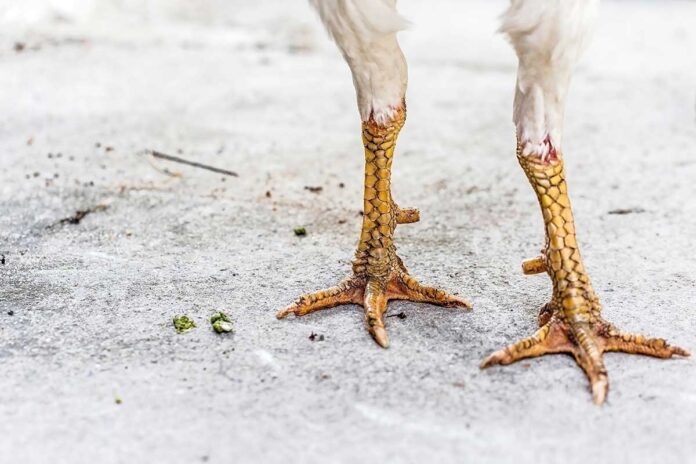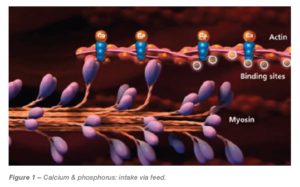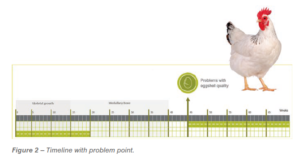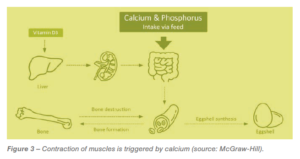
How to optimise muscle function and leg & egg shell strength
The rising demand in commercial layer and parent stock performance increases pressure on the birds to metabolise and mobilise more and more calcium from the intestine to the bones and uterus for eggshell production. The skeletons and dietary requirements of hens are unique relative to the level of calcium intake and the capacity of bone that is constantly being built and resorbed.
Timing is crucial for optimal laying egg performance
The eggshell is formed from calcium carbonate and the layer will metabolize and transport the total weight of her skeleton several times to produce eggshells during the course of the laying cycle. The hen requires approximately 2.5 g calcium in around 20 h to produce a fully developed egg of 60 g. About 60-70% of the required calcium can be provided via the feed which is not enough to cover the peak in calcium requirement during eggshell formation. All the rest has to be metabolised from the bodily reserves which is a unique but delicate system. Creating and maintaining a strong skeleton by assuring the provision and availability of essential nutrients is vital to ensure a productive laying hen.

Vitamin D3 is key to the maintenance of calcium homeostasis by stimulating its absorption and uptake. Deficiencies of this mineral can result in sub-optimal skeletons and eggshells.
Creating a strong skeleton
The development of the structural bones occurs during the rearing phase at which the layer has nearly achieved a mature skeletal frame size. From 15 weeks to 25 weeks hens develop their ovaries and the reproductive tract which also drives the formation of medullary bone and stops the formation of structural bone. It is therefore of importance that the formation of bones is optimal before the onset of sexual maturity.
Maintaining a strong skeleton
Medullary bone is a unique woven bone which functions as a calcium reserve for the eggshell formation when feed is insufficient. Medullary bone is ideally the first source mobilised when more calcium is required. As modern hybrid laying hens have been bred for high egg production and medullary bone is formed as soon as egg production starts, there is a high risk that it loses its structure and therefore strength resulting in leg problems, especially in older birds. Age of the layer is the most determining factor of eggshell breaking strength and quality. Especially in older hens (>40 weeks of age) eggshell quality is deteriorating and is mainly reflected in an increase of cracked eggs.
Timing is crucial
Intra Calferol is a liquid mixture of concentrated and stabilised Vitamin D3 alongside organic calcium and magnesium and a phosphorus releaser. Supplementation is crucial to support the creation of a strong skeleton and also upon experiencing egg shell quality issues. The advised dosage is 1 L Intra Calferol per 1,000 L of drinking water. Taking these two critical periods into consideration, the right times to provide supranutritional support with Intra Calferol are:
• During rearing

– First 20 weeks: 1 day / week
• When experiencing egg shell quality problems in older layers
– First 2 weeks: 6 days / week
– Thereafter: 3 days / week.
Fortification of muscle functioning
In production animals, we know that calcium is essential for a strong skeleton and good eggshell quality. But did you also know that it plays a critical role in muscle functioning?
The process of muscle contraction is one that is regulated by calcium. Muscles are bundles of strong fibres made up of interlocking protein filaments. The muscle contracts by having these filaments slide past each other, thus shortening the entire muscle. To achieve this contraction, calcium is necessary to ‘unblock’ the binding sites on the filaments, thus allowing the filament to be pulled along and cause a shortening of the bundle. To put it simply, calcium is necessary for the sliding of these filaments past each other and creating a strong and optimal muscle contraction.
Relax those muscles!
Besides muscle contraction, the relaxation of the muscles is important. Magnesium plays an important role in regulating muscle contraction by blocking the effects of calcium, thus in contrast allowing the muscle to relax.

The heart is a muscular organ and sufficient Ca2+ is needed for a proper heart contraction. Calcium is necessary for the muscle (heart) contraction and neurotransmission. Activating the muscle function improves the robustness of animals. It has often been observed that broilers are more lively after administration of Intra Calferol, partially by getting the lethargic ‘sitters’ on the move again. In laying hens it is can facilitate an easier egg laying process.
The need for calcium around parturition
The body maintains very tight control over the calcium levels in the blood at any given time. The balance is regulated by an elegant interplay of calcium absorbed from the intestines, transport of calcium into and out of the bones, and the kidney’s recycling and excretion of calcium into the urine.
In genetically selected, high producing animals like sows and dairy cows around and during parturition, calcium requirements are shifted towards uterine contractions and colostrum secretion. This drastic shift of calcium away from the blood can cause issues such as stillbirths and milk fever, especially when there are already inadequate reserves. With its high concentration of Vitamin D3, Intra Calferol helps to reduce risks of these calcium related complications by regulating calcium metabolism.
Intra Calferol – with concentrated Vitamin D3 for superior calcium metabolism
To ensure that calcium metabolism is kept at its optimal, Vitamin D3 is necessary to enhance its absorption from feedstuffs in the gastrointestinal tract. Without Vitamin D3, the body would be unable to absorb calcium and thus not be able to maintain balance of calcium. This would certainly cause deleterious effects related to muscle contraction.
The vitamin D3 content in Intra Calferol, together with the unique balance between organic chelated calcium & magnesium and phosphorus releaser, is contributing to a fortification of the optimal muscle functioning and improving liveability and viability of all animals described.

















